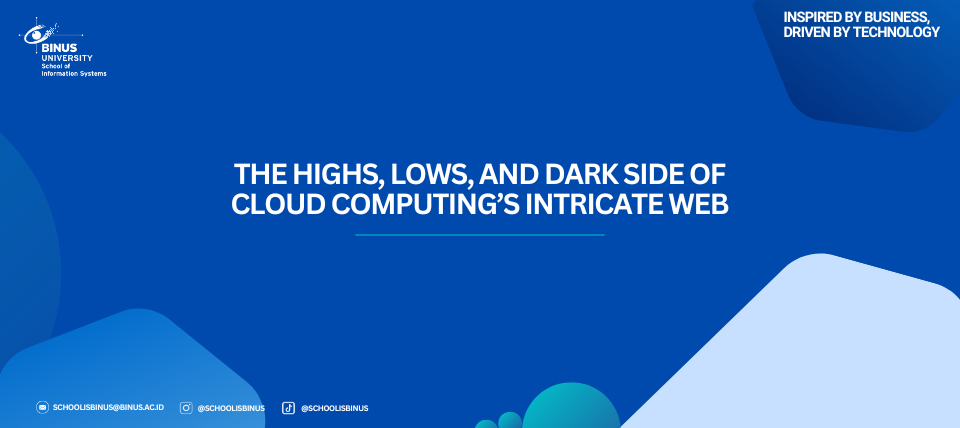The Highs, Lows, and Dark Side of Cloud Computing’s Intricate Web

“The creation of something new is not accomplished by the intellect, but by the play instinct arising from inner necessity. The creative mind plays with the object it loves.” — Carl Jung
The ever evolving nature of technology breeds new needs which in turn creates innovation within the industry, Cloud Computing being one of those needs. Cloud Computing has changed how we as the consumers of technology have gone about our daily lives, from need to bring a hard drive which stores most if not all our files which if lost can create a huge headache for ourselves to no longer going through the that hassle but instead only requiring ourselves to create an account with one the cloud storage services provided by major tech companies. But even so, where did cloud computing even come from, what exactly is it, and is it really purely beneficial for us to use on a daily basis?
The origins of cloud computing can be traced back to the 1960s when DARPA funded MIT to develop multi-user computing technology. Later, J.C.R Licklider’s work on ARPANET (Advanced Research Project Agency Network) helped establish the infrastructure that would eventually enable cloud storage and remote access. According to Foote (2021) thes early advancements laid the groundwork for the cloud-based services we rely on today. In 1999, cloud started to gain some notoriety as companies gained more knowledge and understanding of how to properly integrate it into their system, one of the successful integration was by Salesforce which pioneered the idea of using the Internet to deliver software programs to the end users, and these programs being able to be downloaded and accessed by anyone with Internet access. In the early 2000s is when cloud computing’s significance started showing, particularly with Amazon and Google. Foote (2021) notes that Amazon was one of the first major companies to address the inefficiency of underutilized computing capacity, which led to the launch of Amazon Web Service in 2006, providing online services like storage, computing power, and virtual machines through EC2. Around the same time, Google introduced Google Docs, enabling real-time document editing and online collaboration. By 2007, IBM, Google, and leading universities collaborated to create a server farm for large-scale research projects, highling the growing reliance on cloud-based infrastructure.
Cloud computing’s potential for media streaming also became evident when Netflix launched its streaming service the same year. And with that Foote (2021) also notes many other significant developments in cloud technology which leads us today where we are more or less heavily reliant on its service from doing collaborative work to simply streaming a video to spend leisure time on. But on that note, what exactly is cloud computing?
According to ISO, cloud computing is a paradigm for enabling network access to a scalable and elastic pool of shareable physical or virtual resources with self-service provisioning and administration on-demand. In a more simpler definition, cloud computing is a service on the internet that lets us store, access, and use computing resources over the internet whenever we need them. So is cloud computing mainly beneficial for us?
Cloud computing actually offers a diverse range of services which can be beneficial to businesses and individuals. According to Kepes (2011), some of the key cloud services such as Software as a service, platform as a service, infrastructure as a service provides significant advantages over traditional computing, for example rather than purchasing expensive hardware and software, organizations can simply rent storage, security applications, computing infrastructure and even software, making cloud computing a more flexible and cost-effective. Due to these service models individuals are also able to enjoy everyday life with the implementation of IoT (Internet of Things) devices, such as smart watches, Amazon Echo also known as Alexa, and home automation devices. However, the very features that make cloud computing so appealing also introduce challenges. Businesses and individuals depend on internet connectivity, making them vulnerable to downtime, security breaches, and potential data loss. Moreover, as cloud services grow, many concerning matters start to arise as well such as the data privacy, corporate surveillance, and monopolization by major tech giants makes us question the ethics and regulations regarding this matter.
In conclusion, whether or not cloud computing is completely beneficial is dependent on our ability to navigate its risks responsibly. While it does offer a lot of conveniences, it also introduces a lot of negatives which can be more or less avoided by staying informed about cybersecurity best practices, monitoring for breaches, following and using security measures provided, and even being up-to-date about news of ways people can breach your accounts, users can mitigate or potentially avoid these risks altogether. It’s very unlikely that due to these risks and dark sides we’ll go back to carrying external hard drives, manually managing storage, or worrying about physical data loss since the convenience of instant accessibility and automated security updates has become too valuable. Ultimately, we need to stay vigilant and adapt to cloud computing’s challenges.
References :
- Foote, K. D. (2021, December 17). A Brief History of Cloud Computing. DATAVERSITY. https://www.dataversity.net/brief-history-cloud-computing/
- Kepes, B. (2011). Understanding the cloud computing stack: SaaS, PaaS, IaaS.
- Sether, A. (2016, May 19). Cloud Computing Benefits. Https://Papers.Ssrn.Com. https://papers.ssrn.com/sol3/papers.cfm?abstract_id=2781593
- QA. (2023, July 7). Disadvantages of Cloud Computing. QA. https://www.qa.com/resources/blog/disadvantages-of-cloud-computing/

